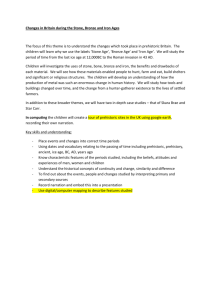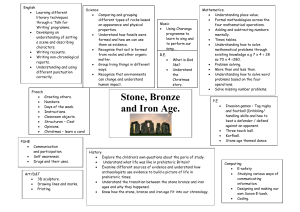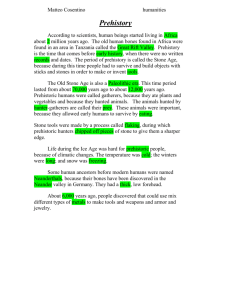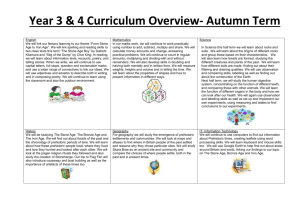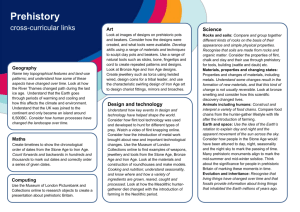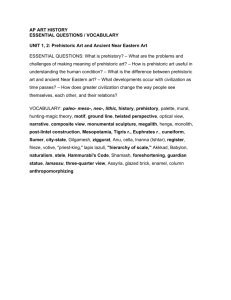prehistoric scotland - Kinross High School
advertisement
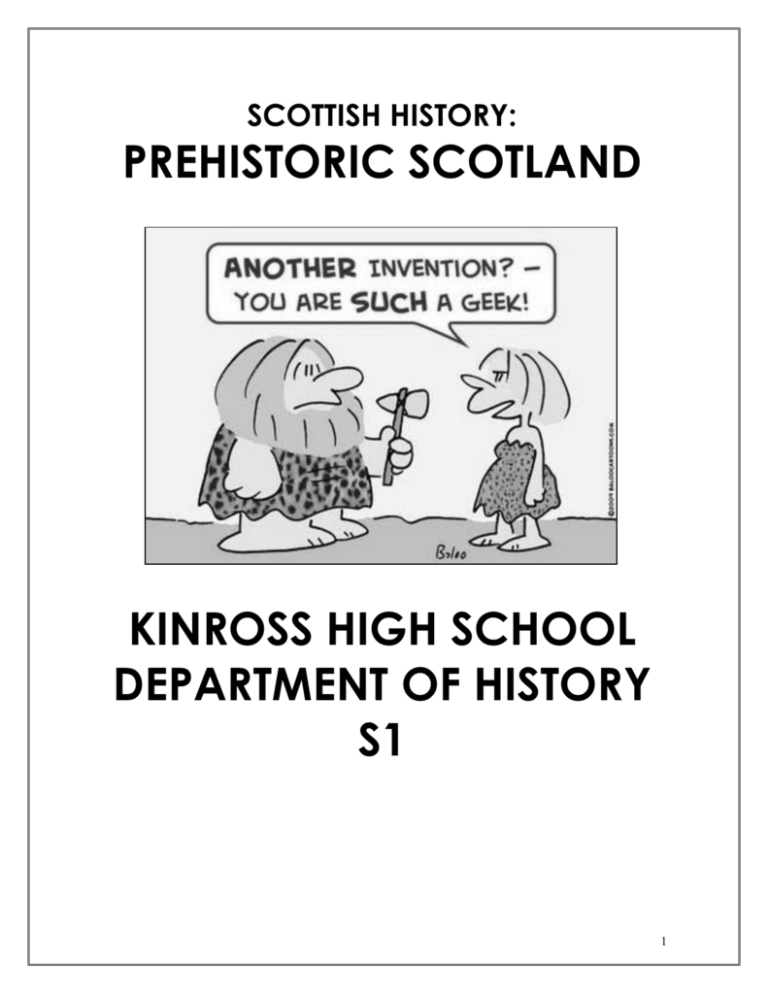
SCOTTISH HISTORY: PREHISTORIC SCOTLAND KINROSS HIGH SCHOOL DEPARTMENT OF HISTORY S1 1 S1 – SCOTTISH HISTORY Before you start your work, here are some points, which we would like you to remember: Please… Do try to keep your jotter as tidy as possible Do write in blue or black ink Do your drawings in pencil and colouring pencil Do date and title all your work Please… Don’t write on the booklets. We want to be able to use them again Don’t leave blank pages in your jotter – if you miss work then copy up 2 WHAT WILL WE LEARN? This unit looks at the very early history of Scotland (and of humans in general). We will find out about the lives of early people and what impact they had on Scotland. In the coming weeks, we will find out about: Early humans The first people of Scotland The first farmers The impact of metal The end of prehistory and the arrival of the Romans The skills/attributes you will develop are: Researching Note-taking Making reasoned judgements Extended writing Understanding bias Working co-operatively with others HOW WILL THE UNIT BE ASSESSED? The unit will be assessed in 3 parts: Part 1: A cartoon strip Part 2: A tourist information booklet Part 3: An end of unit test Depending on how well you perform in these assessments will determine how far along you are in each level. You will be graded by the following stages: Stage 1 = Developing (a basic understanding of the course) Stage 2 = Consolidating (a good understating of the course) Stage 3 = Secure (an excellent understanding of the course) 3 THE FIRST HUMANS Aims: To find out who were the first humans. To find out where the first humans came from. The earliest primate which looked like a human was Australopithecus, who could walk upright. Over many thousands of years Australopithecus developed and their descendents had bigger brains, used simple speech and began to use simple stone tools. These developments marked out humans from animals. Bigger brains meant humans could think deeply about complex things, and together with speech meant they could communicate more effectively. Creating tools gave humans the ability to use their environment more effectively, either for hunting animals, building shelters or harvesting food. This was a key part of our *evolution. Evolution means that the fittest and the strongest survive in their environment. Humans developed effectively in order to survive in a harsh environment. Charles Darwin One of the early thinkers on the theory of evolution. ENVIRONMENTAL CHANGES A few million years ago, Africa was covered, almost edge-to-edge, with dense rain forest. Our ape-like ancestors almost certainly used all four limbs to move, live and hunt in their treetop home. However, massive geological turmoil changed their destiny. The Rift Valley was forming, and the rainforests were dying as Africa dried out - turning the landscape into a mosaic of scattered trees and grass. In this new environment some apes found it more efficient to move about on two legs instead of four. EVOLUTION 4 People, and animals, haven’t always existed on earth in the form they are today. Evolution has meant that over many hundreds of thousands of years ape-like creatures have developed into modern human beings. Evolution occurs when an animal changes. This change can be very small, and can take thousands of years. The change that takes place usually helps the animal to survive. For example, ancestors of the giraffe had short necks, but the ones with slightly longer necks would have been more likely to survive when food was scarce, because they could reach leaves further up trees. Their genes have been passed down to the next generation, and over many thousands of years, the neck of the giraffe has got longer. AUSTRALOPITHECUS Australopithecus walked upright like a human, but its body proportions were like those of a chimpanzee. Like chimps, they had a small brain, long, dangly arms, short legs and a cone-shaped torso with a large belly. Australopithecus facts Meaning: 'Southern Ape’ Lived: 3.9 - 3.0 million years ago. Area: East Africa. Diet: Soft fruit, nuts, seeds, tubers and bird eggs. Size: M: 152cm / 45kg F: 107cm / 28 kg. Brain Size: 35% the size of a modern brain. Around 3.2 million years ago, this ape roamed a mixed habitat of *savannah and woodland beside lakes and floodplains. It foraged for fruit, seeds and nuts and may even have eaten some meat. Australopithecus probably climbed into trees to avoid sabre-toothed cats and to sleep in safety at night. This early human seems to have lived in social groups of between 20 and 30. These groups were probably like those of chimpanzees, in which each individual knows their place. 5 THINGS TO DO: Copy the title ‘The First Humans’ and the two aims from Page 4 of this booklet. Write the sub-title Environmental changes and answer the following questions in sentences: 1. 2. 3. 4. What was Africa covered with a few million years ago? What valley was forming? How did the landscape change? How did this affect some apes? Write the sub-title Evolution 5. Explain what evolution means. 6. Can you think of a feature that another animal has developed in order to survive? Write the sub-title Australopithecus 7. Watch “Walking with Beasts” episode 4 - Next of Kin. Complete handout questions. 8. Describe Australopithecus. 9. What did it eat? 10. How big were Australopithecus social groups? 6 EARLY HUMANS DEVELOP Aims: To find out how humans developed. Over the years humans began to make better tools, by moving from stone, to bronze, to iron tools. Humans also began to organise themselves into larger communities, where people had more specialised jobs, like farmers, or carpenters, or ironmongers or they became leaders or chiefs. When we look at early humans, we find they develop in different sorts of ways. They develop physically: they start to walk upright their brains get bigger their hands become more dextrous they lose their body hair they develop colour vision They develop technically: tools and weapons (like these flint axe heads) farming ways of making useful objects They develop culturally: spoken language written language arts (like these cave paintings from Bulgaria) They develop socially: Different ways of running groups Different roles for different members of the group 7 THINGS TO DO: Copy the title ‘Early Humans Develop’ and the aim from Page 7 of this booklet. 1. Watch “Ray Mears Extreme Survival”. Complete handout. 2. Explain each of the four different ways in which humans developed. Draw a picture next to each of your explanations. 3. Study the table over the page in order to copy and complete the sentences that below. a. Australopithecus lived _________ years ago. 2 million b. Homo Erectus lived ___________ years ago. 100,000 c. Neanderthals lived ____________ years ago. 30,000 d. Cro-Magnon lived ___________ years ago. stone e. Stone Age people made _______ tools. They eventually moved from caves to ________ as the climate got warmer. f. Bronze Age people used ________ tools. At this time _____________ was built in Southern England. g. Iron Age people used _________ tools and weapons. Around this time the metal __________ was being used in farming. bronze iron villages Stonehenge plough 500,000 8 Physical Changes Australopithecus Developments Technical changes Years ago Walked upright simple speech, pebble tools 2,000,000 Homo erectus Less ape-like, bigger brain, used fire, basic stone tools 500,000 Swanscombe Early European, larger brain, fine hand axes 250,000 Neanderthal Large-brained creature, varied flint tool kit 100,000 Cro-Magnon Creatures very similar to us, cave dwellers in winter (painting) Palaeolithic humans (early stone age) 30,000 Bows and arrows, pots, moved from caves to rough shelters as climate got warmer Mesolithic humans (middle stone age) 10,000 Flint craftsmen, farmers, settled in villages Neolithic humans (new stone age) 8,000 Use of metal tools/weapons, Stonehenge Bronze age 6,000 Better weapons, development of ploughs Iron age 3,400 9 PREHISTORIC SCOTLAND – AN INTRODUCTION Aims: Aims: To discover when was the prehistoric period. To find out how we learn about prehistory. Background: When we study history we organise the past into different periods. This unit is about Scotland in the PREHISTORIC PERIOD. This period was a very long time ago, between 2000 and 10,000 years ago. WHEN WAS THE PREHISTORIC PERIOD IN SCOTLAND? Modern Times NOW Early Modern Period begins 500 YEARS AGO Medieval Period begins 1500 YEARS AGO Roman Britain PREHISTORIC PERIOD ENDS Romans come to GB 2000 YEARS AGO The First Metal Workers 3000 YEARS AGO First Farmers in Scotland 4000 YEARS AGO Hunter-Gatherers in Scotland 8000 YEARS AGO 10,000 YEARS AGO Ice Age comes to an end PREHISTORIC PERIOD BEGINS 10 We know that the prehistoric period was thousands of years ago. However, there were no books written during the prehistoric period. So, how do we find out about prehistoric Scotland? HOW DO WE FIND OUT ABOUT THE PREHISTORIC PERIOD? Dig up or *excavate prehistoric places to find archaeological evidence such as pottery, bones & weapons. Take *aerial photographs of places to see the outline of prehistoric sites. Collect soil samples from prehistoric sites. Under a microscope, scientists can work out what grew in the past. 11 THINGS TO DO: Copy the title ‘Prehistoric Scotland – An introduction’ and the two aims from Page 10 of this booklet. 1. Copy this passage filling in the blanks: The Prehistoric Period in Scotland started after the --- age had ended. In the prehistoric period there were Hunter-Gatherers, Fa---- and Met-- Wo-----. It came to a gradual end about 2--- years ago when the R----- came to Scotland. 2. Draw a sketch of yourself thinking about the prehistoric period. In your thought bubble have pictures showing what you think the prehistoric period was like. 3. Use the information on Page 11 to explain how we can learn about the prehistoric period. Make sure that you write in full sentences! EXTENSION 4. Create a timeline of Scotland showing the end of the ice age through to modern times. 12 SCOTLAND AROOUND 10,000 YEARS AGO Aims: To discover what Scotland was like at the end of the Ice Age. To find out who lived in Scotland 10,000 years ago. SCOTLAND AT THE END OF THE ICE AGE Imagine a land that had been completely covered in snow and ice sheets for 2,000,000 years. This is what Scotland was like over 10,000 years ago. Not many plants could grow and not many animals could survive in such freezing conditions. This was the Ice Age. However, around 10,000 years ago the air became warmer and the ice began to melt. As the ice melted a land of mountains, deep valleys, hills and rivers appeared. In this environment more plants began to grow and animals such as ELKS, DEER, WOLVES, BEAR and WILD CATTLE *colonised the countryside. However, at the end of the Ice Age there were still no humans in Scotland. THE FIRST HUMAN SETTLERS Humans (*homo sapiens) had been living in places like Africa & Asia for at least 500,000 years, as there were no ice sheets there. As the ice sheets in the Northern Hemisphere (north half of the world) began to melt, people began to *migrate north through Europe, following herds of animals. The first Homo Sapiens came to Scotland about 9000 years ago. These settlers could make and use fire for protection, food and warmth. They could make tools from wood, stone & bone. They could travel on foot or in little boats called *coracles. They ate what they could find growing around them and hunted for animals. Source A: Scotland around 10,000 years ago 13 THINGS TO DO: Copy the title ‘Scotland about 10,000 years ago’ and write down the 2 aims from Page 1. 1. Describe what Scotland was like over 10,000 years ago. 2. Explain what happened in Scotland at the end of the Ice Age (mention all the changes). 3. Explain who were the first settlers in Scotland and outline how they lived. EXTENSION: 4. Imagine that you are a hunter-gatherer who has followed a herd of elk into Scotland. You have reached the rivers, mountains & forests of Scotland. What challenges would you face? 5. If you were to go back in time and could only take 5 possessions to make your life as a hunter-gatherer easier, what would you take and why? 6. Write the subheading – ‘Action Plan for Survival’ and then explain what steps you would take to make sure that you survived. 14 HUNTER GATHERERS – SETTLEMENTS & TECHNOLOGY Aims: To find out which parts of Scotland were occupied 9000 years ago. To find out what technology was used by hunter gatherers. HUNTER-GATHERERS’ SETTLEMENTS The early settlers in Scotland stayed in a variety of places. Most early settlers avoided settling on high ground (mountains). Hunter-gatherers preferred to live in areas where they could fish and so many settled on the coast or along rivers. Also, hunter-gatherers settled in forests or marshy areas as lots of animals grazed there. Source B: Map of areas settled by hunter gatherers Source C: Flint tools from Fife HUNTER GATHERER’S TECHNOLOGY The hunter-gatherers made tools and weapons from natural resources e.g. bone, antler, wood, animal skin and stone. Fat from whales was used to make light! They also used a hard stone called *flint to make tools and weapons. Flint was not easy to find and it was not easy to shape but it was hard and sharp for successful hunting. Flint could be *knapped to make knives, arrowheads & scrapers. Also, hitting flint together could make sparks, which would be used to light fires. 15 THINGS TO DO: Copy the title ‘Hunter-Gatherers – Settlement & Technology’ and write down the 2 aims from Page 15. 1. Explain where a hunter-gatherer would prefer to stay and why. 2. Write the subheading ‘Map showing areas occupied by hunter gatherers’. Draw the map from Page 6. With a blue colouring pencil shade the COASTAL areas of Scotland where you would find hunter-gatherers and with a green colouring pencil shade the FORESTED and MARSHY areas Scotland where you would find hunter-gatherers. Draw a key for your map. 3. Archaeologists have to make a careful record of the things they find. They record their findings by taking photographs. Also, they do accurate drawings of their finds. For example, if an archaeologist finds 90 pieces of flint, all 90 pieces will be photographed and drawn. The drawings must be as accurate as possible and to scale. a) Explain what flint was used for in the prehistoric period b) Make several accurate drawings of flint tools. Try to show their true size. EXTENSION: 4. Explain what ‘technology’ the hunter-gatherers used (that means what tools, resources and equipment were used). 16 HUNTER GATHERERS – DAILY LIFE Aim: To find out what daily life might have been like for hunter-gatherers. Archaeologists have found evidence to suggest hunter-gatherers were *nomadic – they moved from place to place. They camped in a place as long as there was plenty of food to be found. Often they moved when the seasons changed but returned to the same camp the next year. Camps have been found across Scotland. Archaeologists have found shells, bones and flint remains from prehistoric camps. By studying these finds, it has been possible to piece together a picture of life for huntergatherers. Source E I. After dawn, the males are out hunting – they see a stag in a clearing & fire a flint tipped arrow. The stag is killed. II. They tie the legs of the stag together and fasten it to a long pole. They take it back to the family camp. The flint tip can be used again. III. There is great excitement at the camp – people work with flint knives & scrapers to butcher the stag. IV. The meat is put on a spit above the fire. The skin is scraped to make clothes & shelter. Bone is carved into fishhooks and jewellery. V. In the evening the meat is cooked and eaten with mushrooms, nuts and fruits. The elders tell stories. VI. Winter is coming, the deer have moved & the salmon have swum up river. They load their belongings onto wooden frames & start their journey. 17 THINGS TO DO: Copy the title ‘Hunter-Gatherers – Daily Life’ and write down the aim from Page 17. 1. Make your own illustrated strip showing an average day in the life of a hunter-gatherer. Remember to have both pictures and words and remember that your grade will be higher if you add some of your own ideas and extra information. 2. Draw a table showing your daily life compared to that of a huntergatherer. EXTENSION: 4. Life as a hunter-gatherer would be hard, especially during the winter months. Explain how you think a hunter-gatherer’s life would change through the course of a year. 18 THE FIRST FARMERS Aim: To discover when & why farming came to Scotland. BACKGROUND Around 6000 years ago people who could hunt, gather and FARM appeared in Scotland. The first farmers were different from huntergatherers, as they did not just hunt & gather food to meet day to day needs. They relied on a single harvest for the year. They altered natural systems to grow crops & breed animals. They relied on everybody working together to grow crops and to breed animals instead of relying on the skills of individual hunters. WHY DID PEOPLE START FARMING? People needed more food and a new method of *subsistence. Hunting was often dangerous. Moving from camp to camp was difficult and tiring – people wanted one permanent base. WHAT DID THE FIRST FARMERS DO? The first farmers discovered that keeping and breeding animals meant they could kill animals whenever they wanted. They now had a steady meat supply. They discovered that when trees and stones were cleared away, seed could be sown to grow crops, which provided more grain for throughout the year. They also discovered that it was no longer necessary to keep moving from camp to camp as they could just store grain and meat for the winter months. Farmers were not nomadic. WHAT WERE THE EFFECTS OF FARMING IN SCOTLAND? Because farming meant more food could be produced, people could support more children. So, with the first farmers came an increase in the population. Also, because the farmers were able to store food they had time to make finer, more sophisticated stone tools. 19 THINGS TO DO: Copy the title ‘Prehistoric Scotland – the First Farmers’ and the aim from page 19. 1. Copy the passage, filling in the missing words. The First Farmers had new ideas about keeping a------ and growing -r--n. They lived in --- place and built houses of wood and stone. They used wooden ----ghs to dig up fields. They bred –x--to pull farm equipment. They grew crops such as corn. Ripe corn was ground on a querns---e to make flour. They would mix flour with water to make bread. They had ---- time in the winter to make p------ stone tools. The farmer’s new methods meant that organised, permanent villages could be built. WORD BOX: one polished grain oxen more ploughs *quernstone animals 2. List the similarities and differences between early farmers and huntergathers. Draw a table of changes and continuity. 3. Explain what would be the advantages of being a farmer rather than a hunter? EXTENSION: Try to find gather information on the tools & homes that early prehistoric farmers created. Once you have found information make an illustrated dictionary showing and describing the tools that a farmer would use. Use the example below to get started. Quernstone Plough Pottery Used for grinding ripe corn grains to make flour. Made of stone and have been found in many villages. …………… …………… 20 EARLY FARMERS – SETTLEMENTS Aims: To find out what prehistoric farming villages were like. To find out what the farmers were like. BACKGROUND The first farmers were not nomadic. They chose one place to live permanently. Archaeologists have discovered farming villages across Scotland such as Balbridie in Aberdeenshire and Skara Brae in Orkney BALBRIDIE, ABERDEENSHIRE in Scotland Source F WHAT IS BALBRIDIE LIKE? The archaeological evidence from Balbridie is poor and all that remains is a few pits, postholes and a scatter of household rubbish. At Balbridie, archaeologists have excavated the ‘long house’. Excavations have revealed that the house was nearly 25 metres long and 13 metres wide. The wall was made of wooden posts and woven branches. The roof was thatched and large posts marked the doorway. Fields and grazing areas would have surrounded houses. WHO WOULD HAVE LIVED AT BALBRIDIE? Archaeologists believe that small family groupings of about 6-12 individuals would have lived in settlements like Balbridie. It is thought that the people would be shorter than we are today but their build would be like ours. Diseases ranging from arthritis to tooth decay were common and the age of death was low – many people died when they were about 30 years old. 21 WHAT IS SKARA BRAE LIKE? Not all farming villages are like Balbridie. The prehistoric site of Skara Brae is very different. Skara Brae is on the isle of Orkney. It is the best-preserved prehistoric village in Northern Europe. The village is about 5000 years old and is made up of at least 10 stone houses. The houses are *semisubterranean (below ground level) to keep out strong winds and storms. After about 600 years of living there, sand dunes began to cover over the village. Eventually, the village was covered in sand and no one could live there. About 100 years ago, a huge storm blew away the sand uncovering the remains of the village. Because the site is so well preserved it gives archaeologists a fantastic idea of what farming life was like. THINGS TO DO: Copy the title ‘Early Farmers – Settlements’ and the aims from page 21. 1. Explain the reasons why it is difficult to find out about life at places like Balbridie and Skara Brae. 2. Why is there more evidence of Skara Brae. (You should give at least 2 reasons for your answer.) 3. Describe what many early farming villages & houses were like – make a sketch to illustrate your answer. EXTENSION: 4. Start to find out about Skara Brae. Make notes at the back of your book – collect information on the houses & the artifacts. 22 EARLY FARMERS – SKARA BRAE Aim: To find out about life in prehistoric Skara Brae. WHY DID PEOPLE SETTLE AT SKARA BRAE? Farmers chose to settle here for several reasons: there was good land for growing crops and grazing animals. There was a ready supply of stone for building houses. The cove where they built was sheltered from the winds and finally it would be easy to exploit the sea for fish and driftwood. WHAT HAVE ARCHAEOLOGISTS DISCOVERED AT SKARA BRAE? Stone Houses: They are square shaped with dry-stone walls and flooring. Inside them you see a stone hearth in the middle of the floor, stone beds on either side of the entrance and a stone dresser facing the door. Stone boxes are sunk into the floor for containing water and shellfish. Some of the houses are linked together by dry-stone-walled passages. Tools: Stone tools made of flint & *chert have been found. These stone tools are arrows and scrapers. Larger tools are made of bone because the stone is to hard to shape and breaks easily. People: Bones reveal that the people were like us but a little smaller. We do not know what they wore, as there is no evidence of weaving or spinning but there is evidence that skins and furs were used for clothing. Lots of bone & antler jewellery has been found. Also paint pots have been found which would have been used to decorate the body and to colour carvings Food: By looking in the villager’s rubbish (middens) bones and seeds have been found. We know they ate cows, pig, cod, lobsters, whale, gannets, shellfish, eggs, barley & wheat. They had the ingredients to make beer & bread but archaeologists have no evidence of these. 23 THINGS TO DO: You have been asked to produce a brochure giving information on Skara Brae. You have already learned lots about this Prehistoric Wonder, but you are going to find out more. A brochure is a small leaflet advertising or giving information about something. They are attractive, eye-catching, user friendly and full of interesting information. They are designed to persuade people to spend time and money visiting the site. WHY AM I BEING ASKED TO DO THIS? We want to know how well you can research a project on your own using resources. This will give you a chance to show off your talents and to show just how well you are working in the History Department. We also want to assess your ability to follow instructions. This is to be an example of your best possible work. This means lots of effort to produce the BEST YOU CAN DO! You will be marked and graded on this by your teacher, so it will allow you to demonstrate how well you are working. Your parents will also be aware of how well you are doing, as they will sign the evaluation sheet once it has been completed. HOW DO I KNOW WHAT TO DO TO SUCCEED? All you have to do is follow the simple instructions below, and you can’t help but do well! INSTRUCTIONS: First of all, you need to fold the sheet in an appropriate way to make a brochure (see examples on the wall). It must be your own work, and not copied from books or websites! Your brochure should be word processed if possible, but this is not essential. Either way, it should appear eye-catching and colourful. If it is typed, then you should use a different font/size for the title and headings. You could use the following headings: layout, people, food, tools and discovery, but if you use others, then that is excellent also! Write at least five sentences under each heading. You should include at least three pictures – either from the internet or drawn by hand. You will also be marked on the quality of your written English, so make sure that you proof read your work. Most importantly, the brochure must be interesting and informative. Make sure you use appropriate language for a brochure, like we discussed in class. You will get extra marks for including something unique in your brochure – it’s up to you! Good luck, and ask for help if you need it! 24 THE FIRST METAL WORKERS Aims: To find out when people started to make metal. To find out how metal was made. BACKGROUND During the early farming period people depended on stone for tool making. However, by 2000BC developed farmers discovered that they could make the metal *bronze. It could be used to make tools, weapons and jewellery. HOW DID PREHISTORIC PEOPLE MAKE METAL TOOLS? About 4000 years ago (2000BC) developed farmers discovered that if you melted tin and copper together you could get a stronger metal called bronze. Bronze was useful as it had a sharper cutting edge and was strong. MAKING BRONZE 1. To make a bronze axe a metal worker would need an axe mould, a clay pot, some pieces of tin and copper and a fire. 2. The metal worker would light a fire then use it to heat the copper and tin pieces in the clay pot. The fire melts the tin and copper so that they become runny. 3. The metal worker would pour the runny liquid into a stone mould and let it cool. As the liquid cools it becomes hard and can be carefully levered out the mould to form an axe. Metal working farmers exported tin into Britain from overseas. As they exported tin they came into contact with people who could make IRON. This metal was even harder than bronze allowing stronger iron tools and weapons to be made. 25 THINGS TO DO: Copy the title ‘The First Metal Workers’ and the aims from page 25. 1. Which prehistoric people were the first to make their own metal tools and when did they discover how to make bronze? 2. How did prehistoric people make flat bronze axes? (use words and pictures to explain your answer). 3. What difficulties might a metal worker face when making a FLAT BRONZE AXE? Explain at least three difficulties. EXTENSION: 4. Read Source G below and use it to list three reasons why bronze tools were more useful than stone tools. Source G: from ‘Ancient Scotland’ The advantage of bronze tools is that if they become blunt they can be hammered sharp again. Furthermore, if they break they can be melted down again to make new tools. Also, they can be made to have very sharp cutting edges. 5. Read Source H. Explain who used bronze tools and what they were used for. Source H: from ‘Ancient Scotland’ Archaeologists believe that many developed farmers did not have bronze goods. They think that it was the richer, more powerful farmers and warriors who had bronze goods. When bronze tools are found they show little sign of having been used and so they must have had some other purpose. The tools were not used because they were considered too precious to use. They were meant to show a person’s importance and *prestige. 26 PREHISTORIC SCOTLAND - AN END Aims: To find out when prehistory ends in Scotland To understand the achievements of prehistoric people BACKGROUND From about 120BC onwards the people of Great Britain became more closely involved with their foreign neighbours - the ROMANS. This great civilisation was becoming more powerful, influencing most of Europe. People in the south of England were trading with Romans to get goods such as olive oil & wine. Gradually the rest of Britain came into contact with Romans. WHEN DID THE ROMANS COME TO SCOTLAND? By the year 78AD the Romans had Southern Britain under their rule. In 78AD the Roman Emperor, Vespasian decided that he wanted to explore and conquer the rest of the island. So, he sent his governor, Julius Agricola to fight the 'CALEDONIANS' (the Scots). Even though Agricola failed to control the Scots, he and those Romans who came after him brought changes to Scotland including new buildings, new religions, new settlements and new foods. WHY DOES THE ARRIVAL OF THE ROMANS MEAN AN END TO PREHISTORY? For the archaeologist the arrival of the Romans brought an end to Prehistoric Scotland. The term prehistory refers to periods of the past where there are no written primary sources. However, the Romans, when they came into contact with Britain, wrote about the islanders. They provided historians with primary written evidence. Therefore, the prehistoric period ended and the historic period started. 27 THINGS TO DO: Copy the title ‘Prehistoric Scotland - An End and aims from page 27. 1. Explain when and why Britain came into contact with the Romans. 2. Explain some of the changes that the Romans made to Britain. 3. In your own words explain when & why prehistory ends in Scotland. 4. List as many of prehistoric peoples achievements that you can think of: 5. Read the information below: Source I: written by a student in the year 2010 Prehistoric People lived basic lives and must have been fairly simple to have not invented electricity, cars or computers. I think that they must have been quite stupid to not invent things like bicycles or clocks! 6. Use the source and your own knowledge to explain if you agree with this point of view. Use evidence to support your answer. 28 PREHISTORIC SCOTLAND - GLOSSARY Words marked with * are in the glossary New words and their meaning: 1. 2. 3. 4. 5. 6. 7. 8. 9. 10. 11. 12. 13. 14. 15. 16. 17. 18. 19. Aerial Photography – photographs of archaeological sites taken from the air ( allows archaeologists to see outlines of ancient buildings and fields) Archaeologist – someone who studies the past and digs up sites Bronze – metal made from melting tin and copper Colonised – when people settle an area Continuity – when things stay the same over a period of time Coracle – small prehistoric boat made from animal skin and wood Evolution – the theory that a species develops over time through ‘survival of the fittest’ Excavate – to dig up an area of archaeological interest Flanged axe – two sided axe Flint – hard stone used for tools Homo Sapiens – human beings (us!) Knapping – hitting flint together to make tools or sparks Migrate – to move to another country Nomadic – to travel from place to place without one permanent home Prestige – importance Quernstone – stone used for grinding grain to make flour Savannah – an area of grassland with trees that are spread out Semi-subterranean – partly below ground Subsistence – method of survival (food and drink) 29
